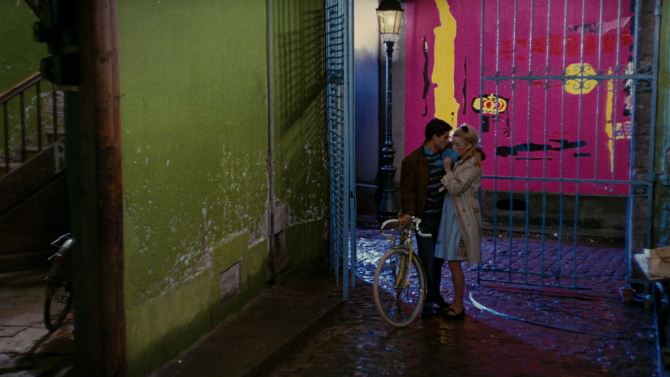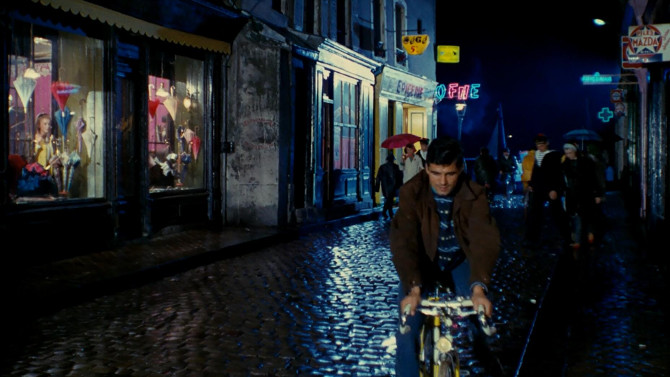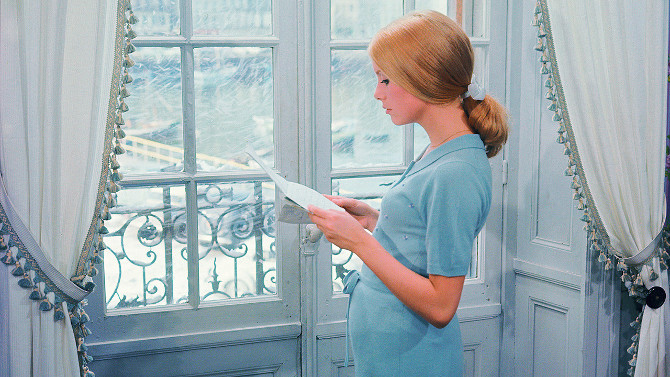Landing somewhere in between French New Wave, older classic French features and the grand Hollywood musical, Jacques Demy’s 1964 colourful kaleidoscopic romantic drama, The Umbrellas of Cherbourg, is most definitely not your typical movie musical.
Firstly, there is no dancing (a standard in musicals), rather, Demy orchestrates many lengthy choreographed takes with his camera – it adding the graceful movement that would usually be asked of the actors. But, more importantly, and at greater risk, every single line of dialogue in Cherbourg is sung. Perhaps a bit daunting to movie audiences, it does, in some ways, make sense. I have never bought into the idea that people would just randomly break into song and dance at any given time. . . only a few films giving some sort of reason for this (see Singin’ in the Rain and La La Land), so it is more plausible, in this vividly toned movie landscape, that people naturally sing all the time – this means no distracting breaks between song and talk.
Shot on location in the streets, shops and apartments of Cherbourg, France, Demy’s tale (which he also wrote), is divided into three parts (each with a distinctive and very different tone), the first being The Departure. Love is in the air, specifically, first love, as the seventeen year old daughter of Madame Emery – an umbrella store owner (Anne Vernon), Geneviève (Catherine Deneuve), is attached at the hip to a local mechanic, Guy Foucher (Nino Castelnuovo). . . a twist on the age old story of star-crossed lovers. The cobblestone streets, bubblegum colours, and striking patterned wallpapers coming to life much like the burgeoning relationship – as if the city itself was intertwined with the ardour of the young couple.
Yet, fate raises its uncaring hand and Guy is drafted into the army, soon to be sent to Algeria. Likewise, Madame Emery is behind on payments, meaning that she and her daughter must sell off her prized jewellery to a wealthy bachelor jeweller, Roland Cassard (Marc Michel). . . ahh, the complications of life.
Spending their first night together on the eve of his departure, it will be at least two years before the pair will see each other again – though both proclaim their respective love for the other, and insist that they will wait. This leads into parts two and three: The Absence and The Return. Will the couple find love once again or will war and time force them apart?
A fascinating example of film making, Demy wrote the dialogue, having no clue as to what the music would sound like. Working with Michel Legrand, they developed the jazzy score (that would push the story forward like an opera), having to time it to the very second along with what would happen onscreen (as the movements and dialogue were intricately timed). The actors, not being singers, had to lip sync to the music with clockwork precision.
With stellar character arcs, the ordinary individuals at the centre of the narrative remind the viewer of their own first loves, and how life, at times, can be bittersweet. Geneviève and Guy are young, still blissfully innocent, though circumstances that arise change that quite quickly. With her beloved leaving for war, she must deal with an unexpected predicament, as well as the persistence of Roland, who has also been ensnared by her beauty. As for when Guy returns, he is a shell of the man he once was. He does not fit into the joyfully shaded areas of Cherbourg he once thrived in, now finding his way to the earthier toned railway station and docks. He is wounded, unkempt and no longer has the same cherub-like demeanor, his stark disillusionment seeping into a city of warmth.
And, for a moment, I’d like to turn to the finale, without giving too much away. Look to the muted colours, the snow, the location, and listen to the music, as it demonstrates the complexity of things. There is love, melancholy, hope and loss, sadness and happiness in equal measure.
The winner of the Palme D’or at the Cannes Film Festival, The Umbrellas of Cherbourg is a unique and influential piece of cinema. One of Damien Chazelle’s favourite movies, it is clearly etched into his much lauded feature from last year, La La Land. It is even paid tribute to in a less expected place, the animated television series Futurama. Intriguingly, it is set between two other Demy films, Lola and The Young Girls of Rochefort as a loose romantic trilogy – for instance, Marc Michel plays the same character in Lola (Roland), telling of the love he once held for Lola in this film. And, to conclude, one more comment must be made on the colours. Playful and creative, the palettes often change in fascinating ways, with colours that were once the dominant background becoming a single focal point in the next room while another tone takes over (visually mesmerizing). With the motion picture’s concluding notes taking place at Christmas time, this is the perfect moment to discover, or re-discover, this thoughtful musical. So, take a chance on this classic French film, it proves that every cloud has a silver lining – especially when you have such a posh umbrella.
This film is in French with English subtitles





It sounds uplifting. I don’t usually like musicals , but I do love Catherine Deneuve.But with subtitles and musical , probably take a pass